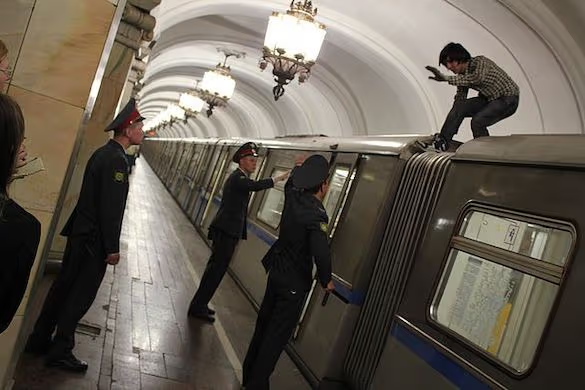Subway Surfers Chase Viral Fame Along With Illegal Thrills
People riding outside train cars has long been a problem in New York City, but TikTok appears to be adding fuel to the phenomenon, as surfers rack up views after posting videos in violation of the platform’s rules.

TikTok appears to be adding new fuel to a phenomenon that has worried parents in New York City for decades: subway surfing. The app’s failure to enforce its terms of service could be contributing to an uptick in sightings of adolescents riding on the outsides of train cars.
Subway surfing is the term for illegally riding on the tops or backs of trains. Although neither the NYPD nor the MTA track data on subway surfing specifically, a look at social media will show that there are a lot of people, particularly young people, riding on the tops of subway cars.
“This is obviously illegal, dumb, and dangerous,” the New York City Transit president, Richard Davey, told the Sun. “It’s also selfish because when it ends badly — as it has — riders get stranded and transit workers, firefighters, police, and medical examiner’s recovery teams are put at risk dealing with the clean up.”
Although data on incidents of subway surfing are unavailable, the MTA does take note of when the stunts go wrong. Over the past three years there have been two fatalities and four injuries associated with the illegal maneuver.
Recently, a group of eight people were captured on video “surfing” the J train as it ran through Williamsburg. The police say an “investigation is ongoing.”
While this particular incident made the evening news, there are a huge number of such videos online. The most popular of TikTok’s many tags relating to the topic “nyc surf train” has racked up more than 9.5 billion views since being posted.
It is easy to find videos posted by dozens of users who record themselves riding on the backs or tops of trains, under tags such as “#trainsurfnyc” or “#trainsurf.”
Per its community guidelines, TikTok says it does “not permit users to share content depicting, promoting, normalizing, or glorifying dangerous acts that may lead to serious injury or death.”
This includes “dangerous games, dares, challenges, or stunts that might lead to injury or property damage.” TikTok has not responded to the Sun’s request for comment.
Although subway surfing videos officially violate TikTok’s policies, it’s easy to find them. Often, videos are uploaded and then rack up hundreds or thousands of views before being taken down. Other times TikTokers seem to circumnavigate the rules with disclaimers or excuses.
One video depicting a group of young people climbing on top of an above-ground train reads, “Unrelated surf simulator vr — Not real don’t take down.” The video, which is clearly not virtual reality, has been up since May 30.
Another video of train surfing from May 28 says, “This is fake it’s called will vr,” which so far is apparently enough for TikTok to allow the video to stay up.
A video from June 15 clearly violates the platform’s policies by presenting a first-person view of someone climbing on top of a train saying, “Take the risk Brah.”
Another TikToker skirts the rules by claiming to be a “TRAINED PREFFESIONAL.” This account has videos of subway surfing from as far back as March 21.
While it is impossible to draw a direct line between the decision someone makes to surf a train and whatever TikToks they may have seen, videos of train surfing are clearly popular on the platform, and the links between such media and risk-taking behavior is well documented.
Researchers at Columbia have studied the phenomenon and have come to the conclusion that, though social media may not be directly to blame for the subway surfing phenomenon, it could be responsible for its apparent increase in popularity.
“Adolescence is a time of risk-taking, which is both a strength and a vulnerability,” a medical psychologist, Clauge Mellins, wrote. “Social media can exacerbate risks, as we have seen played out in the news.”
An author of a metaanalysis of studies on social media and its relationship to risk-taking in adolescents described social media as a “super peer” that influences young people.
“In over 67,000 adolescents we found that those who are engaging in social media more are much more likely to be engaging in a wide range of risky behavior including sexual behavior and drinking,” researcher Anna Vannucci said.
She explained that research consistently finds that social media use correlates with an increased likelihood of participating in behaviors such as train surfing.
“What we think based on our results from our research is that teens now are much more likely to engage in risk taking than in any other time period,” she added.
She said it was plausible that social media could be responsible for a recent uptick in train surfing, possibly giving those with a predisposition to risky behavior the nudge they need to take part in the action.
With nearly 500 subway stations across New York City, there are plenty of opportunities. People concerned about the dangers can help by flagging such content on TikTok and other platforms and by reporting subway surfer sightings to the police.

